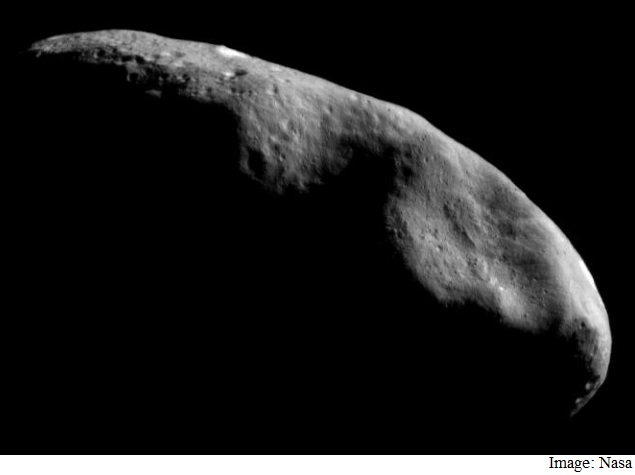- Home
- Science
- Science News
- Nasa Probe Indicates Asteroid Vesta Once Had Flowing Water: Study
Nasa Probe Indicates Asteroid Vesta Once Had Flowing Water: Study

Vesta, visited by Dawn from 2011 to 2013, was once thought to be completely dry, incapable of retaining water because of the low temperatures and pressures at its surface.
However, a new study shows evidence that Vesta may have had short-lived flows of water-mobilised material on surface.
"Nobody expected to find evidence of water on Vesta. The surface is very cold and there is no atmosphere, so any water on the surface evaporates," said Jennifer Scully, postgraduate researcher at the University of California, Los Angeles.
"However, Vesta is proving to be a very interesting and complex planetary body," said Scully.
"These results, and many others from the Dawn mission, show that Vesta is home to many processes that were previously thought to be exclusive to planets," said UCLA's Christopher Russell, principal investigator for the Dawn mission.
Scully and colleagues identified a small number of young craters on Vesta with curved gullies and fan-shaped deposits.
"We're not suggesting that there was a river-like flow of water. We're suggesting a process similar to debris flows, where a small amount of water mobilises the sandy and rocky particles into a flow," Scully said.
The curved gullies are significantly different from those formed by the flow of purely dry material, scientists said.
"These features on Vesta share many characteristics with those formed by debris flows on Earth and Mars," Scully said.
The gullies are fairly narrow, on average about 30 metres wide. The average length of the gullies is about 900 metres.
The leading theory to explain the source of the curved gullies is that Vesta has small, localised patches of ice in its subsurface.
No one knows the origin of this ice, but one possibility is that ice-rich bodies, such as comets, left part of their ice deep in the subsurface following impact.
A later impact would form a crater and heat up some of the ice patches, releasing water onto the walls of the crater.
"If present today, the ice would be buried too deeply to be detected by any of Dawn's instruments," Scully said.
"However, the craters with curved gullies are associated with pitted terrain, which has been independently suggested as evidence for loss of volatile gases from Vesta," said Scully.
Also, evidence from Dawn's visible and infrared mapping spectrometer and gamma ray and neutron detector indicates that there is hydrated material within some rocks on Vesta's surface, suggesting that Vesta is not entirely dry.
It appears the water mobilised sandy and rocky particles to flow down the crater walls, carving out the gullies and leaving behind the fan-shaped deposits after evaporation.
The craters with curvy gullies appear to be less than a few hundred million years old, which is still young compared to Vesta's age of 4.6 billion years.
The finding was published in the journal Earth and Planetary Science Letters.
For the latest tech news and reviews, follow Gadgets 360 on X, Facebook, WhatsApp, Threads and Google News. For the latest videos on gadgets and tech, subscribe to our YouTube channel. If you want to know everything about top influencers, follow our in-house Who'sThat360 on Instagram and YouTube.
Related Stories
- Samsung Galaxy Unpacked 2025
- ChatGPT
- Redmi Note 14 Pro+
- iPhone 16
- Apple Vision Pro
- Oneplus 12
- OnePlus Nord CE 3 Lite 5G
- iPhone 13
- Xiaomi 14 Pro
- Oppo Find N3
- Tecno Spark Go (2023)
- Realme V30
- Best Phones Under 25000
- Samsung Galaxy S24 Series
- Cryptocurrency
- iQoo 12
- Samsung Galaxy S24 Ultra
- Giottus
- Samsung Galaxy Z Flip 5
- Apple 'Scary Fast'
- Housefull 5
- GoPro Hero 12 Black Review
- Invincible Season 2
- JioGlass
- HD Ready TV
- Laptop Under 50000
- Smartwatch Under 10000
- Latest Mobile Phones
- Compare Phones
- Moto G15 Power
- Moto G15
- Realme 14x 5G
- Poco M7 Pro 5G
- Poco C75 5G
- Vivo Y300 (China)
- HMD Arc
- Lava Blaze Duo 5G
- Asus Zenbook S 14
- MacBook Pro 16-inch (M4 Max, 2024)
- Honor Pad V9
- Tecno Megapad 11
- Redmi Watch 5
- Huawei Watch Ultimate Design
- Sony 65 Inches Ultra HD (4K) LED Smart TV (KD-65X74L)
- TCL 55 Inches Ultra HD (4K) LED Smart TV (55C61B)
- Sony PlayStation 5 Pro
- Sony PlayStation 5 Slim Digital Edition
- Blue Star 1.5 Ton 3 Star Inverter Split AC (IC318DNUHC)
- Blue Star 1.5 Ton 3 Star Inverter Split AC (IA318VKU)

















